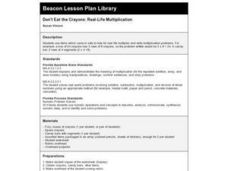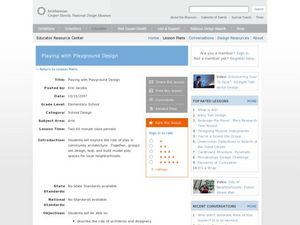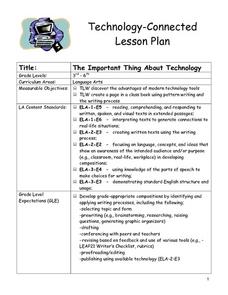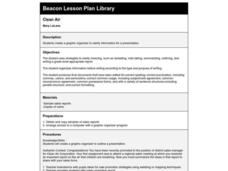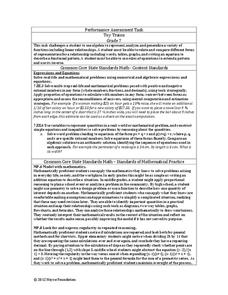Curated OER
Don't Eat the Crayons: Real-Life Multiplication
Third graders use items which come in sets to look for real-life multiples and write multiplication problems. This lesson assess the student's understanding of the meaning of multiplication using an array model and manipulatives.
Curated OER
Using Each Trait to Improve Student Writing
Students study examples of each trait in literature. They discuss how each trait adds to the craft of writing and practice revision of a writing piece with a particular trait in focus. They rate their writing on the trait of Ideas using...
Curated OER
Critical Literacy in the 21st Century
Listen to Sitti's Secrets and have your class discuss their opinions about Arab families. They will become familiar with the Palestinian /Arabic Culture through a critical literacy focus. Students will write a persuasive...
Curated OER
Studying An Artist
Young scholars examine the artwork of a specific artist and attempt to create a painting in the style of the studied artist in this middle and high school level Art lesson. Rubric is included for self- and teacher assessment after the...
Curated OER
Digital Poetry Books
Young scholars, after reviewing the writing process and assessing how to use a digital camera to take creative photos, create a Digital Poetry Book. They incorporate the use of Microsoft Photo Draw and Publisher for the creation of their...
Curated OER
Insulators and Conductors
Fourth graders experiment to discover which items are conductors and which items are insulators. In this insulators and conductors lesson, 4th graders experiment and create a T-Chart. Students are assessed on the correctness...
Curated OER
Where are you Spider?
First graders investigate the proximity of objects in space. In this proximity lesson, 1st graders place a felt spider in different locations on a teacher made book, and they describe its proximity to certain items in that book. Students...
Curated OER
Bread Cells
Fifth graders examine plant and animal cells. In this plant and animal cell lesson, 5th graders define what cells are, label their parts, and describe how plant and animal cells are different. They observe cells at a number of web sites,...
Curated OER
An Introduction to Light Unit-Third Grade
Third graders are introduced to light in an eight part unit which includes activities, additional resources, and rubrics for each part. Students address topics such as energy, reflection, absorption, and refraction through hands-on...
Curated OER
Mind Reader
First graders engage in a game which helps them recognize the word wall words. In this word lesson plan, 1st graders are given clues to follow, to determine the word on the wall. Students are assessed based on teacher observations....
Curated OER
"Interviews:" Analyzing Interviews To Make A Career Connection
Students assess how people currently employed got their jobs and the process they went through to be interviewed for the positions they acquired. They analyze how their past job experiences have helped them obtain their current jobs.
Curated OER
Playground Design
Learners design recreational equipment for a community. In this architecture lesson, students work in pairs to design the equipment. Learners select materials and begin designing. Students assess themselves with a pre-made rubric.
Curated OER
The Beginnings of Constitutional Government
Students examine excerpts of Thomas Paine's Common Sense. In this early American history lesson, students read Paine's pamphlet and analyze the information according the rubric provided.
Curated OER
The "Art" of Baseball
Students investigate the art of baseball. In this sports lesson, students discuss their thoughts about the sport of baseball and create a baseball word list. Students use pattern blocks and drawing paper to create a...
Curated OER
The Important Thing About Technology
Students assess the advantages of modern technology tools by creating a page in a class book utilizing pattern writing as well as the writing process. They organize and develop a composition on a selected topic after going through the...
Curated OER
Summing Up the Disaster
Learners are introduced to news writing being a concise, factual, and informative type of writing. They assess that publishing an article in a newspaper style utilizes a word processing program. Each student researches the Titanic and...
Curated OER
Healthy Eating
Students explore how they can make healthy food choices and assess how "eating healthy" requires knowledge and planning ahead. They review and discuss The Edible Pyramid as well before they complete this project online. Each student maps...
Curated OER
Clean Air
High schoolers read sales promotion reports and create a sales promotion summary using information from the report. They develop a graphic organizer to outline their information for a presentation. There is an assessment checklist...
Curated OER
World War II Webquest
Tenth graders work with a partner to locate and follow the directions of a webquest of their choice. Using the internet, they research their topic in depth and write a paper on their findings. They are assessed by the criteria on the...
Curated OER
Critiquing A Speech Contestant
What makes a speech effective? Middle schoolers critique a speech for content and presentation. They view a video of a middle school student presenting an informational speech, They outline the content of the speech and critique the...
Curated OER
Hurricane and Tornadoes Vocabulary
Quiz your young meteorologists using this simple matching worksheet. Learners inventory 16 weather-related terms, matching them to the appropriate definition on the right. There are an equal number of definitions as there are terms. A...
Noyce Foundation
Toy Trains
Scholars identify and continue the numerical pattern for the number of wheels on a train. Using the established pattern and its inverse, they determine whether a number of wheels is possible. Pupils finish...
Inside Mathematics
Graphs (2006)
When told to describe a line, do your pupils list its color, length, and which side is high or low? Use a learning exercise that engages scholars to properly label line graphs. It then requests two applied reasoning answers.
Inside Mathematics
Coffee
There are many ways to correlate coffee to life, but in this case a worksheet looks at the price of two different sizes of coffee. It requires interpreting a graph with two unknown variables, in this case the price, and solving for...
Other popular searches
- Self Assessment Rubrics
- Art Assessment Rubrics
- Science Assessment Rubrics
- Portfolio Assessment Rubrics
- Reading Assessment Rubrics
- Writing Assessment Rubrics
- Project Assessment Rubrics
- Assessment Rubrics for Maps
- Assessment Rubrics for Mapd
- Assessment Rubrics for Ma Pd
- Music Assessment Rubrics


